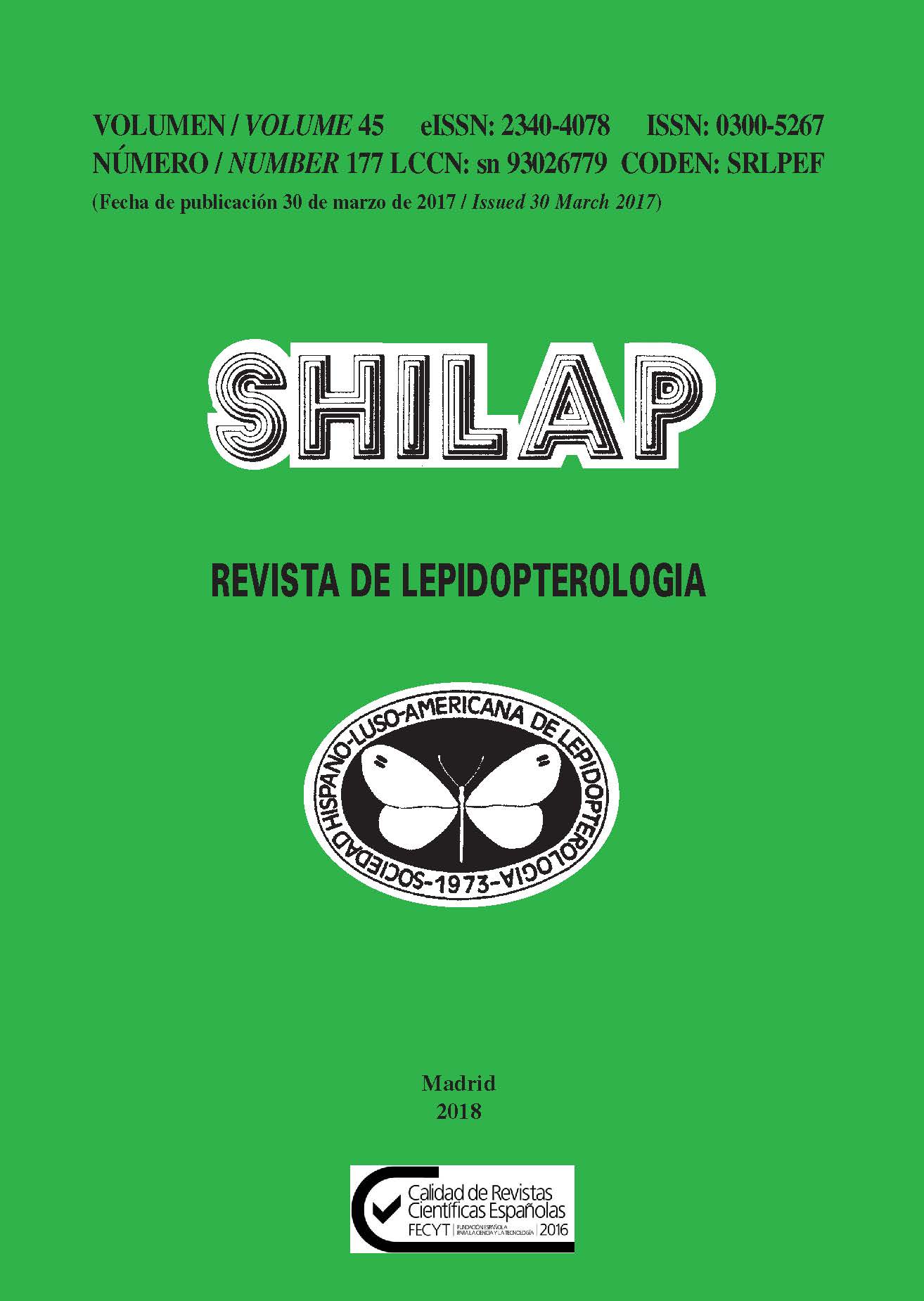Geometridae Stephens, 1829 de diferentes altitudes de las áreas protegidas del Himalaya occidental de Uttarakhand, India (Lepidoptera: Geometridae)
DOI:
https://doi.org/10.57065/shilap.978Palabras clave:
Lepidoptera, Geometridae, diversidad, altitud, Oeste del Himalaya, indicador de especies, Uttarakhand, IndiaResumen
Los Geometridae Stephens, 1829 se consideran como un grupo modelo excelente para estudiar a nivel global, los patrones de diversidad de los insectos a lo largo de gradientes de elevación. Este trabajo documenta a 168 especies de Geometridae pertenecientes a 99 géneros y 5 subfamilias de diferentes áreas protegidas en el estado del Himalaya occidental, Uttarakhand, en India. La lista incluye 36 especies registradas por primera vez de Uttarakhand, que ha sido mal explorado hasta ahora y revela la expansión del alcance altitudinal de al menos 15 especies.
Estudiamos muestras de distintas zonas de vegetación de elevación entre los 600 m y los 3.600 m, en el área de Dehradun-Rajaji, Parque Nacional de Nanda Devi, Parque Nacional del Valle de las Flores, Reserva Natural de Govind, Parque Nacional de Gangotri y Reserva Natural de Askot. La subfamilia Ennominae supone el mayor número de especies, pero se encontró que las especies de la subfamilia Larentiinae eran más restringidas a las áreas más elevadas. El bosque mixto de coníferas occidental reúne el mayor número de especies, mientras que el bosque subalpino se caracteriza por incluir el mayor número de especies indicadoras, identificadas por medio del análisis de especies indicadoras. Mientras que las especies indo-malayas dominan la composición del conjunto, el máximo número de endemismos del Himalaya, sugiere que estas especies están más adaptadas al gradiente climático del Himalaya desde hace tiempo y las perturbaciones climáticas actualmente en curso, podrían dificultar su futura supervivencia.
Descargas
Estadísticas globales ℹ️
|
842
Visualizaciones
|
1064
Descargas
|
|
1906
Total
|
|
Citas
ASHTON, L. A., ODELL, E. H., BURWELL, C. J., MAUNSELL, S. C., NAKAMURA, A., MCDONALD, W. J. F. & KITCHING, R. L., 2016.– Altitudinal patterns of moth diversity in tropical and subtropical Australian rainforests.– Austral Ecology, 41(2): 197-208. DOI: https://doi.org/10.1111/aec.12309
ASHTON, L. A., KITCHING, R. L., MAUNSELL, S., BITO, D. & PUTLAND, D., 2011.– Macrolepidopteran assemblages along an altitudinal gradient in subtropical rainforest exploring indicators of climate change.– Memoirs of the Queensland Museum, 55: 375-389.
AXMACHER, J., HOLTMANN, G., SCHEUERMANN, L., BREHM, G., MÜLLER-HOHENSTEIN, K. & FIEDLER, K., 2004.– Diversity of geometrid moths (Lepidoptera: Geometridae) along an Afrotropical elevational rainforest transect.– Diversity and Distributions, 10: 293-302. DOI: https://doi.org/10.1111/j.1366-9516.2004.00101.x
BARLOW, H. S., 1982.– An Introduction to the Moths of South East Asia: 305 pp. Malayan Nature Society, Kuala Lumpur.
BECK, J., BREHM, G. & FIEDLER, K., 2011.– Links between the environment, abundance and diversity of Andean moths.– Biotropica, 43: 208-217. DOI: https://doi.org/10.1111/j.1744-7429.2010.00689.x
BECK, J., SCHULZE, C. H., LINSENMAIR, K. E. & FIEDLER, K., 2002.– From forest to farmland: diversity of geometrid moths along two habitat gradients in Borneo.– Journal of Tropical Ecology, 17: 33-51. DOI: https://doi.org/10.1017/S026646740200202X
BENISTON, M., DIAZ, H. F. & BRADLEY, R. S., 1997.– Climate change at high elevation sites: an overview.– Climate Change, 36: 233-251. DOI: https://doi.org/10.1023/A:1005380714349
BREHM, G. & FIEDLER, K., 2003.– Faunal composition of geometrid moths changes with altitude in an Andean montane rain forest.– Journal of Biogeography, 30: 431-440. DOI: https://doi.org/10.1046/j.1365-2699.2003.00832.x
BREHM, G., COLWELL, R. K. & KLUGE, J., 2007.– The role of environment and mid-domain effect on moth species richness along a tropical elevational gradient.– Global Ecology and Biogeography, 16: 205-217. DOI: https://doi.org/10.1111/j.1466-8238.2006.00281.x
BREHM, G., STRUTZENBERGER, P. & FIEDLER, K., 2013.– Phylogenetic diversity of geometrid moths decreases with elevation in the tropical Andes.– Ecography, 36: 1247-1253. DOI: https://doi.org/10.1111/j.1600-0587.2013.00030.x
BREHM, G., SÜSSENBACH, D. & FIEDLER, K., 2003.– Unique elevational patterns of geometrid moths in an Andean montane rainforest.– Ecography, 26: 456-466. DOI: https://doi.org/10.1034/j.1600-0587.2003.03498.x
BURWELL, C. J. & NAKAMURA, A., 2011.– Distribution of ant species along an altitudinal transect in continuous rainforest in sub-tropical Queensland, Australia.– Memoirs of Queensland Museum, 55: 391-411.
CHAMPION, H. G. & SETH, S. K., 1968.– A revised survey of forest types of India: 404 pp. Government of India Press, New Delhi.
CHAWLA, A., RAJKUMAR, S., SINGH, K. N., LAL B. & THUKRAL, A. K., 2008.– Plant species diversity along an altitudinal gradient of Bhabha Valley in Western Himalaya.– Journal of Mountain Science, 5: 157–177. DOI: https://doi.org/10.1007/s11629-008-0079-y
CHEN, I. C., SHIU, H. J., BENEDICK, S., HOLLOWAY, J. D., CHEY, V. K., BARLOW, H. S., HILL, J. K. & THOMAS, C. D., 2009.– Elevation increases in moth assemblages over 42 years on a tropical mountain.– Proceedings of the National Academy of Sciences, 106(5): 1479-1483. DOI: https://doi.org/10.1073/pnas.0809320106
CHEY, V. K., HOLLOWAY, J. D. & SPEIGHT, M. R., 1997.– Diversity of moths in forest plantations and natural forests in Sabah.– Bulletin of Entomological Research, 87: 371-385. DOI: https://doi.org/10.1017/S000748530003738X
COLWELL, R. K. & CODDINGTON, J. A., 1994.– Estimating terrestrial biodiversity through extrapolation.– Philosophical transactions of the Royal Society London, 345: 101-118. DOI: https://doi.org/10.1098/rstb.1994.0091
DUFRENE, M. & LEGENDRE, P., 1997.– Species assemblages and indicator species: the need for a flexible asymmetrical approach.– Ecological Monographs, 67: 345-366. DOI: https://doi.org/10.1890/0012-9615(1997)067[0345:SAAIST]2.0.CO;2
FOSTER, P., 2001.– The potential negative impacts of global climate change on tropical montane cloud forests.– Earth-Science Reviews, 55: 73-106. DOI: https://doi.org/10.1016/S0012-8252(01)00056-3
GRAHAM, C. H., PARRA, J. L., RAHBEK, C. & MCGUIRE, J. A., 2009.– Phylogenetic structure in tropical hummingbird communities.– Proceedings of the National Academy of Science, 106: 19673-19678. DOI: https://doi.org/10.1073/pnas.0901649106
HAMPSON, G. F., 1892.– Fauna of British India including Ceylon and Burma-Moths, 1: 527 pp. Taylor & Francis, London.
HAMPSON, G. F., 1894.– Fauna of British India including Ceylon and Burma-Moths, 2: 609 pp. Taylor & Francis, London.
HAMPSON, G. F., 1895.– Fauna of British India including Ceylon and Burma-Moths, 3: 546 pp. Taylor & Francis, London.
HAMPSON, G. F., 1896.– Fauna of British India including Ceylon and Burma-Moths, 4: 594 pp. Taylor & Francis, London.
HILT, N., BREHM, G. & FIEDLER, K., 2006.– Diversity and ensemble composition of geometrid moths along a successional gradient in the Ecuadorian Andes.– Journal of Tropical Ecology, 22: 155-166. DOI: https://doi.org/10.1017/S0266467405003056
HODKINSON, I. D., 2005.– Terrestrial insects along elevation gradients: species and community responses to altitude.– Biological Reviews, 80: 489-513. DOI: https://doi.org/10.1017/S1464793105006767
HARUTA, T. (eds.), 1994.– Moths of Nepal, Part 3, Tinea. 14 (Supplement 1): 171 pp. Japan Heterocerists’ Society, Tokyo.
HARUTA, T. (eds.), 1995.– Moths of Nepal, Part 4, Tinea. 14 (Supplement 2): 206 pp. Japan Heterocerists’ Society, Tokyo.
HARUTA, T. (eds.), 1998.– Moths of Nepal, Part 5, Tinea. 15 (Supplement 1): 330 pp. Japan Heterocerists’ Society, Tokyo.
HARUTA, T. (eds.), 2000.– Moths of Nepal, Part 6, Tinea. 16 (Supplement 1): 163 pp. Japan Heterocerists’ Society, Tokyo.
HOLLOWAY, J. D., 1985.– Moths as indicator organisms for categorizing rain-forest and monitoring changes and regeneration process.– In A. C. CHADWICK & S. L. SUTTON (eds). Tropical rain-forest: the Leeds Symposium. Leeds Philosophical and Literary Society: 235-242 pp. Leeds.
HOLLOWAY, J. D., 1987.– Macrolepidoptera diversity in the Indo-Australian tropics, geographic, biotopic and taxonomic variations.– Biological Journal of the Linnean Society, 30: 325-341. DOI: https://doi.org/10.1111/j.1095-8312.1987.tb00306.x
HOLLOWAY, J. D., 1993.– The moths of Borneo (part 11); Family Geometridae: Subfamilies Ennominae.– Malayan Nature Journal, 47: 1-309.
HOLLOWAY, J. D., 1996.– The moths of Borneo (part 9); Family Geometridae: Subfamilies Oenochrominae, Desmobathrinae, Geometrinae.– Malayan Nature Journal, 49: 147-326.
HOLLOWAY, J. D., 1997.– The moths of Borneo (part 10); Family Geometridae: Subfamilies Subfamilies Sterrhinae, Larentiinae, Addenda to other subfamilies.– Malayan Nature Journal, 51: 1-242.
HOLLOWAY, J. D., 1998.– The impact of traditional and modern cultivation practices, including forestry, on Lepidoptera diversity in Malaysia and Indonesia.– In D. M. NEWBERY. Dynamics of Tropical Communities: 567-597 pp. Cambridge University Press, London.
INTACHAT, J., HOLLOWAY, J. D. & SPEIGHT, M. R., 1997.– The effects of different forest management practices on geometrid moth populations and their diversity in Peninsular Malaysia.– Journal of Tropical Forest Science, 9: 411-430.
KESSLER, M., 2002.– The elevational gradient of Andean plant endemism: varying influences of taxon-specific traits and topography at different taxonomic levels.– Journal of Biogeography, 29: 1159-1165. DOI: https://doi.org/10.1046/j.1365-2699.2002.00773.x
KITCHING, R. L., ORR, A. G., THALIB, L., MITCHELL, H., HOPKINS, M. S. & GRAHAM, A. W., 2000.– Moth assemblages as indicators of environmental quality in remnants of upland Australian rain forest.– Journal of Applied Ecology, 37: 284-297. DOI: https://doi.org/10.1046/j.1365-2664.2000.00490.x
MCGEACHIE, W. J., 1989.– The effects of moonlight illuminance, temperature and wind speed on light-trap catches of moths.– Bulletin of Entomological Research, 79: 185-192. DOI: https://doi.org/10.1017/S0007485300018162
PARMESAN, C., 2006.– Ecological and evolutionary responses to recent climate change.– Annual Review of Ecology, Evolution, and Systematics, 37: 637-669. DOI: https://doi.org/10.1146/annurev.ecolsys.37.091305.110100
RAHBECK, C., 1997.– The relationship among area, elevation, and regional species richness in Neotropical birds.– The American Naturalist, 149: 875-902. DOI: https://doi.org/10.1086/286028
SANDERS, N. J. & RAHBEK, C., 2012.– The patterns and causes of elevational diversity gradients.– Ecography, 35: 1-3. DOI: https://doi.org/10.1111/j.1600-0587.2011.07338.x
SCHULZE, C. H., 2000.– Auswirkungen anthropogener Störungen auf die Diversität von Herbivoren-Analyse von Nachtfalterzönosen entlang von Habitatgradienten in Ost- Malaysia. 350 pp. Ph. D. Thesis, University of Bayreuth.
SCOBLE, M. J. & HAUSMANN, A., 2007.– Online list of valid and nomenclaturally available names of the Geometridae of the world. Available from http://www.lepbarcoding.org/cl_geometridae.php (accessed 4th February, 2016).
SCOBLE, M. J., 1995.– The Lepidoptera: Form, Function and Diversity: 420 pp. The Natural History Museum and Oxford University Press, Oxford.
SCOBLE, M. J., GASTON, K. J. & CROOK, A., 1995.– Using taxonomic data to estimate species richness in Geometridae.– Journal of the Lepidopterists’ Society, 49: 136-147.
SMETACEK, P., 2008.– Moths recorded from different elevations in Nainital District, Kumaon Himalaya, India.– Bionotes, 10: 5-15.
STORK, N. & BRENDALL, M., 1990.– Variation in the insect fauna of Sulawesi trees with season, altitude and forest type. Insects and the rain forests of South East Asia.– Wallacea, 7: 173-190.
SZUMIK, C., AAGESEN, L., CASAGRANDA, D., ARZAMENDIA, V., BALDO, D., CLAPS, L. E., CUEZZO, F., GOMEZ, J. M. D., DI GIACOMO, A., GIRAUDO, A., GOLOBOFF, P., GRAMAJO, C., KOPUCHIAN, C., KRETZSCHMAR, S., LIZARRALDE, M., MOLINA, A., MOLLERACH, M., NAVARRO, F., NOMDEDEU, S., PANIZZA, A., PEREYRA, V.V., SANDOVAL, M., SCROCCHI, G. & ZULOAGA, F. O., 2012.– Detecting areas of endemism with a taxonomically diverse data set: plants, mammals, reptiles, amphibians, birds and insects from Argentina.– Cladistics, 28: 317-329. DOI: https://doi.org/10.1111/j.1096-0031.2011.00385.x
WALIA, V. K., 2005.– Insecta: Lepidoptera: Geometridae: 181-190.– In H. S. MEHTA (ed.). Fauna of Western Himalaya, 2: 358 pp. Zoological Survey of India, Kolkata.
WEBB, C. O., ACKERLY, D. D., MCPEEK, M. A. & DONOGHUE, M. J., 2002.– Phylogenies and community ecology.– Annual Review of Ecological Systematics, 33: 475-505. DOI: https://doi.org/10.1146/annurev.ecolsys.33.010802.150448
WILLIAMS, S., 1997.– Patterns of mammalian species richness in the Australian tropical rainforests: are extinctions during historical contractions of the rainforest the primary determinants of current regional patterns in biodiversity?- Wildlife Research, 24: 513-530. DOI: https://doi.org/10.1071/WR96040
WILLIAMS, S. E., SHOO, L. P., HENROID, R. & PEARSON, R. G., 2010.– Elevational gradients in species abundance, assemblage structure and energy use of rainforest birds in the Australian Wet Tropics bioregion.– Austral Ecology, 35: 650-664. DOI: https://doi.org/10.1111/j.1442-9993.2009.02073.x
YELA, J. L. & HOLYOAK, M., 1997.– Effects of moonlight and meteorological factors on light and bait trap catches of noctuid moths (Lepidoptera: Noctuidae).– Population Ecology, 26: 1283-1290. DOI: https://doi.org/10.1093/ee/26.6.1283
ZOU, Y., SANG, W., HAUSMANN, A. & AXMACHER, J. C., 2016.– High phylogenetic diversity is preserved in species-poor high-elevation temperate moth assemblages.– Scientific Reports 6: 23045; doi:10.1038/srep23045(2016). DOI: https://doi.org/10.1038/srep23045
Publicado
Cómo citar
Número
Sección
Licencia

Esta obra está bajo una licencia internacional Creative Commons Atribución 4.0.
El autor retiene sus derechos de marca y patente sobre cualquier proceso o procedimiento dentro del artículo.
El autor retiene el derecho de compartir, distribuir, ejecutar y comunicar públicamente el artículo publicado en SHILAP Revista de lepidopterología, con reconocimiento inicial de su publicación en SHILAP Revista de lepidopterología.
El autor retiene el derecho para hacer una posterior publicación de su trabajo, de utilizar el artículo a publicarlo en un libro, siempre que indique su publicación inicial en SHILAP Revista de lepidopterología.
Cada envío a SHILAP Revista de lepidopterología debe ir acompañado de una aceptación de los derechos de autor y del reconocimiento de autoría. Al aceptarlos, los autores conservan los derechos de autor de su trabajo y aceptan que el artículo, si es aceptado para su publicación por SHILAP Revista de lepidopterología, tendrá una licencia de uso y distribución “Reconocimiento 4.0 Internacional de Creative Commons” (CC BY 4.0), que permite a terceros compartir y adaptar el contenido para cualquier propósito dando el crédito apropiado al trabajo original.
Puede consultar desde aquí la versión informativa y el texto legal de la licencia. La indicación de la licencia CC BY 4.0 debe indicarse expresamente de esta manera cuando sea necesario.
A partir de 2022, el contenido de la versión impresa y digital se encuentra bajo una licencia de uso y distribución “Reconocimiento 4.0 Internacional de Creative Commons” (CC BY 4.0), que permite a terceros compartir y adaptar el contenido para cualquier propósito dando el crédito apropiado al trabajo original.
El contenido anterior de la revista se publicó bajo una licencia tradicional de derechos de autor; sin embargo, el archivo está disponible para acceso gratuito.
Al usar el contenido de SHILAP Revista de lepidopterología publicado antes del año 2022, incluidas figuras, tablas o cualquier otro material en formato impreso o electrónico pertenecen a los autores de los artículos, los autores deben obtener el permiso del titular de los derechos de autor. Las responsabilidades legales, financieras y penales a este respecto pertenecen al autor(es).
En aplicación del Principio de Prioridad del Código Internacional de Nomenclatura Zoologica, no se autoriza el depósito en repositorios, páginas web personales o similares de cualquier otra versión distinta a la publicada por el editor.




























